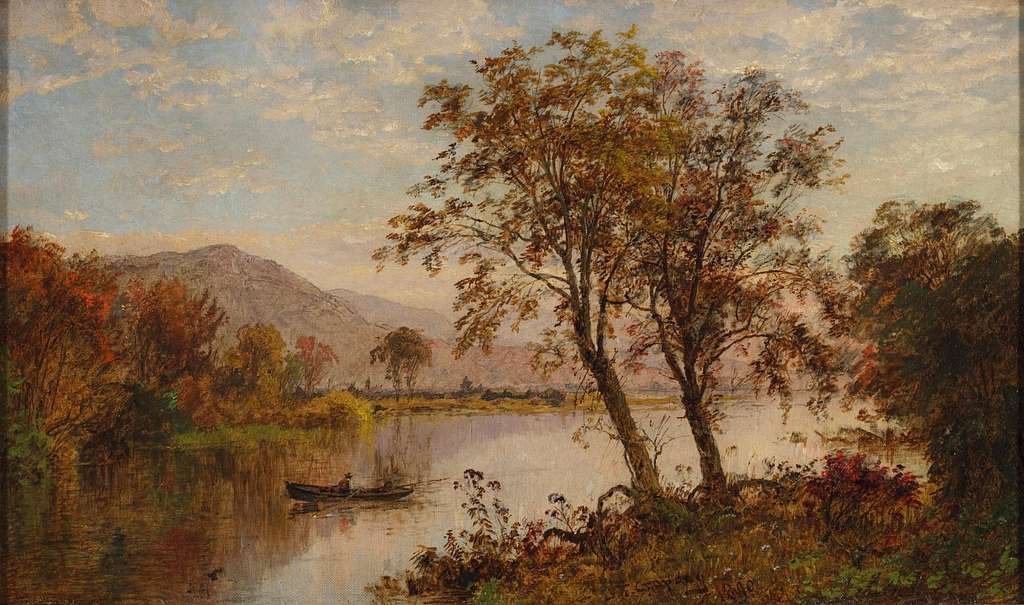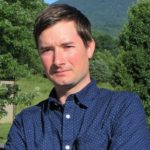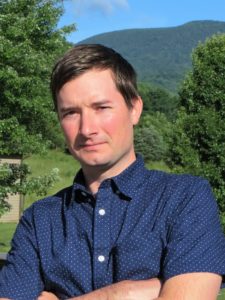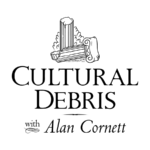One Saturday morning in late autumn, while my daughters were in ballet practice across town, I took a right rather than my usual left on Buena Vista’s river walk. Locals pronounce their Shenandoah Valley town’s name with a Virginia drawl—“Byoona”-vista—or shorten it to an affectionate “BV.” Buena Vista is a struggling industrial town, with more than its share of empty storefronts and abandoned warehouses, but it is also a determined one, bolstered by some remaining industry, a small Latter-day Saints liberal arts college, and tremendous town spirit: many homes and businesses display signs cheering on the high school sports teams (“Go Blues!”). Buena Vista is also aptly named given how the Blue Ridge Mountains rise up behind it. Backpackers from the nearby Appalachian Trail at times stride through town at a brisk thru-hiker’s pace, making their way to the laundromat, dollar store, soda shop, or one of BV’s two local barbecue joints (both excellent).
I have been fond of BV since first moving to the outskirts of nearby Lexington nearly a decade ago. BV reminds me of similar industry-and-farming towns in Central Pennsylvania where I grew up: Mount Union, Huntingdon, Tyrone. My fondness for BV has grown in recent months as I have come to know it better. Instead of sitting in the waiting room of my daughters’ ballet studio during their practices, scrolling on my smartphone or staring at the cardboard clock and wooden cannon stashed from previous Nutcracker performances, I started taking long walks around town. These walks, like most walks, were good for the soul. They offered time to think and observe and occasionally to converse with other walkers, porch sitters, or townspeople working in their yards. I discovered that you don’t really know a town until you walk it and walk it regularly.
I occasionally took to the river walk trail, which runs along the Maury River levee on BV’s outskirts, but I had never taken a right on the levee trail until that day. Perhaps I was unconsciously seeking new scenery to pull me out of a funk. I had no contemplative ease at the start of this walk. Mulling over work responsibilities and a long weekend to-do list, I trudged deeper into annoyance at how Nutcracker practice had claimed so much of my Saturday. I was cooped up in the confines of my head, effectively elsewhere, while my body mechanically walked the BV trail. In his famous essay on “Walking,” Henry David Thoreau remarks, “I am alarmed when it happens that I have walked a mile into the woods bodily, without getting there in spirit.” Indeed.
Then the gadfly graffiti brought me to a stop and made me smile. Someone had blazoned “Socrates” on a cement structure where the trail climbed back up to the crest of the levee. It was painted in the stylized slash lettering one might see on a heavy metal album cover, red paint outlined by white. A red upraised fist added an exclamation beside the philosopher’s name. Who? Perhaps a Southern Virginia University student inspired by Philosophy 101? An eccentric autodidact? A graffitist with a shelf of Loeb editions at home? Why? The fist suggests that the graffitist wanted to evoke one common image of Socrates: the rebel-for-the-truth who is ready to face the worst in the Apology rather than to compromise himself and his philosophical vocation. Fair enough. We need such heroes. But as I stood there musing, I thought about the location of the graffiti, on the slope up the levee, where the Maury River and the woods beyond would soon come back into view, and I considered that perhaps the graffitied “Socrates” was also a call to contemplation, a call to the kind of receptive rumination that makes perambulating such an important practice for philosophers, artists, poets, mathematicians, and mystics. Such a call to contemplation might seem incongruous with the fist-raised aerosol urgency, but there’s Socratic irony for you.
I lingered with the gadfly graffiti for a time, and when I continued to the top of the levee, I found myself a good deal more attentive to my surroundings. The graffiti drew me out of my Saturday funk. It drew me into both the place and the moment. I periodically stopped to watch a bevy of cattails orbiting in the wind or ducks floating on the current, bobbing almost perpendicular as they entered a stretch of brisk, eddying riffles. A walk along flowing water, with its movement, depths, and duration, is particularly well-suited for contemplation. As Ishmael observes in the opening chapter of Herman Melville’s Moby-Dick: “Take almost any path you please, and ten to one it carries you down in a dale, and leaves you there by a pool in the stream. . . .Yes, as every one knows, meditation and water are wedded for ever.” Melville helped me move from the Socrates of the Apology to the Socrates of the Phaedrus, where the city’s great philosopher takes his own amble along the river Ilissos, for once contemplating nature. This Socrates was my companion on the trail. The gadfly graffiti gathered town, woods, and river around his name.
The gadfly graffiti is somewhere between a philosophical exhortation and an artwork, and its effect on me illustrates something that philosophy and art often share. Both can shake us out of habits and preoccupations, out of complacent and inattentive ways of seeing ourselves, others, and the world. They can defamiliarize. They can get us to see and think more deeply, more carefully. And we often continue seeing and thinking this way as we turn from the philosophical work or the artwork back to the wider world. In On Beauty and Being Just, Elaine Scarry notes how “attention to any one thing normally seems to heighten, rather than diminish, the acuity with which one sees the next.” This is often salutary for the one attending, granting fuller moments and richer experience. As Scarry suggests, however, heightened attention has ethical and even political affordances as well.
Of course, there is another irony in how the gadfly graffiti had me reflecting on an affinity between philosophy and art. Socrates infamously quarrels with the poets and artists in the Republic. He claims that art is thinly mimetic, that it offers a mere copy (a copy-of-a-copy actually, far removed from the ideal Forms), and a potentially misleading copy at that. In short, the Socrates of the Republic claims that art leads to superficial seeing rather than heightened contemplative attention. But then there is the fact that the dialogue with Glaucon and Adeimantus is Plato’s own artful philosophical drama, an invitation to recognize his performative irony. And then there is Socrates’ nod to the inspired poets in the Phaedrus, the Socrates who joins a pair of poets as a fellow storyteller in the Symposium, along with the old legends that Plato was first a playwright and that Socrates was Euripides’ silent co-writer. As literary-philosophical-spiritual works, Plato’s dialogues invite us to see afresh, to be struck with wonder or reduced to aporia (which may at times be the same thing). Like some graffiti, the Platonic dialogues are works of art in their own right. They never come simply from a desire to deface art. The dialogues are gadflies to contemplation, rousing us out of complacency.
At least that is what I found myself contemplating as I left the river walk and made my way back to the ballet studio. I was grateful to Socrates and to the graffitist that carried his legacy into this time, into this place. In a funk no more, I was prepared to meet the smile of my daughters with a genuine smile of my own as they came out of practice. The graffiti was gadfly, but also gift.
Image Credit: Jasper Francis Cropsey, “View on the Hudson River” (1890) via Picryl







2 comments
Steve Knepper
Thank you, Madeleine. Maybe we can meet up at Straws Soda Shop next time you are in the Shenandoah Valley. It’s my favorite BV spot these days.
Madeleine
Fantastic essay. What a treat it is to read about home. I also appreciate seeing BV through your eyes. As a cadet, it made me sad to see it so run down sometimes. I can’t wait to go back with new eyes.
Comments are closed.